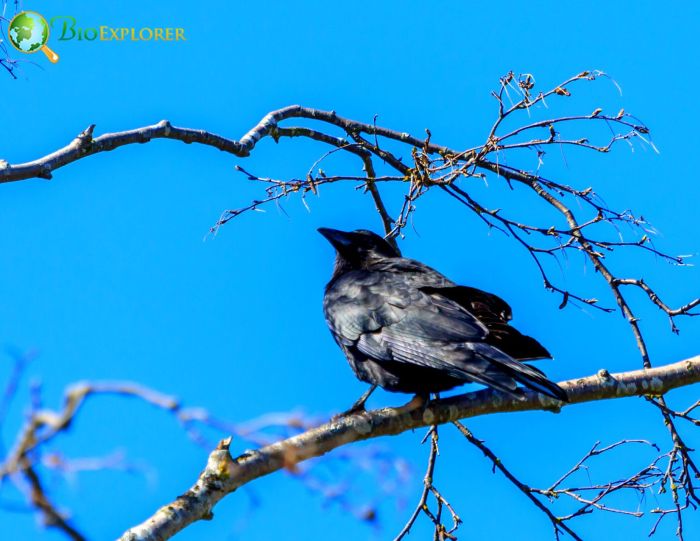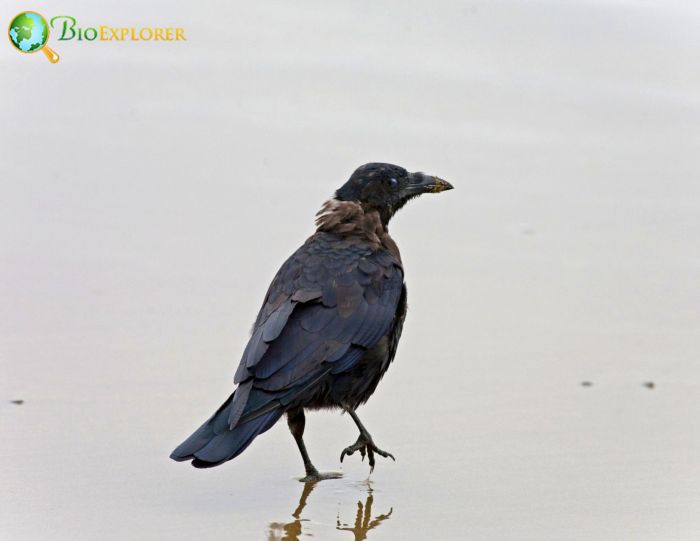
| Animalia | Passeriformes | Corvidae | Corvus | Corvus caurinus |
Table of Contents
- Northwestern Crow Physical Characteristics
- Northwestern crows have an extensive communication system
- Northwestern crows cache food for later use
- Impact of Northwestern Crows on the Ecosystem
- Northwestern crows enjoy maneuvering while flying
- Northwestern crows excel at mobbing predators
- Frequently Asked Questions
- What is the difference between an American Crow and a Northwestern Crow?
- Where is the northwestern crow?
- How big are northwestern crows?
The northwest crow (Corvus caurinus) solely inhabits the northeastern Pacific Ocean coast between southern Alaska and the northern tip of Washington. Although they do not always reside in forests, they often live close to them.

In the winter, when the weather is very bad, they retreat to the forest’s edge. They can be located even up to 1700 meters above sea level.
Northwestern Crow Physical Characteristics

Having a length of 41.9 to 44.5 cm and a weight of 340 to 440 g, Northwestern crows can be categorized as medium-sized birds.
- These black birds have a wingspan of around 99 cm. Their head, neck, back, wings, and tail are covered with iridescent black feathers with bluish-violet accents.
- Their shiny, robust bills are smaller and less strong than those of Common Ravens (Corvus corax), and they have brownish-grey eyes with smokey undertones.
- They also have feathers that resemble bristles protecting their nares. Large scales are exclusively present on the front side of Corvus caurinus’s broad, large black legs.
- While at rest, their folded wings’ tips do not reach the tips of their tails, which have slightly rounded ends.
- Although the male is somewhat bigger than the female, the sexes are similar in appearance[1].
Although less iridescent than adults, C. caurinus juveniles between the ages of 3 and 15 months are similarly black. Their tail, wings, and back feathers gradually turn brown from black. Young C. caurinus between the ages of one and three months have dull black feathers looser and fluffier than those of adults or immatures. Their eyes are blue.
Northwestern crows have an extensive communication system

Northwestern crows mostly use calls for communication.
- They have a wide spectrum of calls, ranging from begging or feeding calls to calls for territorial defense.
- Males have a special call they employ to tell females to come and receive some food when they bring it.
- In roosting groups, they are noisy and utilize warning cries. Mob calls to quickly mobilize the entire colony to frighten away a potential predator.
- They also make certain visual displays to claim dominance, establish territorial rights, and indicate their readiness to mate.
Northwestern crows cache food for later use

The Northwestern Crow stores food in the morning and nighttime.
- Clams, Cormorant eggs, crabs, and fish are the main items that they save. Food that has been cached is normally retrieved in 24 hours.
- They also carry cached food for young females laying eggs. During high tide at the start of the breeding season, food caching appears to occur primarily.
- Food security for the female and nestlings at a time when food can be in short supply is considered one of the principal purposes of food storage.
- Food is hidden by the Northwestern crows along rocks and in plants. They frequently try to bury the food, and they appear to remember where it is so they can find it again.
Impact of Northwestern Crows on the Ecosystem

Humans benefit greatly from the cleaning services provided by Northwestern Crow.
- It keeps garbage and carrion away from riverbanks and shorelines. Additionally, it is crucial for maintaining the stability of tide pool habitats.
- According to studies, Northwestern Crows and other predatory seabirds play a key role in regulating sea urchin populations.
- The Northwestern crows control clam and crab populations, reducing overcrowding and preserving biodiversity in the ocean and intertidal zones.
Northwestern crows enjoy maneuvering while flying

Northwestern crows glide around cliffs using strong winds and a steady, consistent wingbeat.
- They have a faster wing-beat than American crows and travel at a speed of roughly 30 km/h. In flight, they can maneuver quite well.
- They have also been observed enjoying games, leaping into the air with a stick or stone in their beak or claws, dropping it, and rushing back down to reclaim it.
- They frequently soar high into the air with small invertebrates like clams, crabs, and sand dollars and then dump them on rocks to crack them open.
Northwestern crows excel at mobbing predators

The safety of their roosting mates is essential to the social nature of Northwestern crows.
- They use calls to warn one another of approaching predators, crowd the actual or possible predator, and call loudly as a group.
- When calling down to predators, they frequently alight above them. They have mobbed household cats, dogs, hawks, owls, grey squirrels, northern harriers, and even humans.
- They also pursue young squirrels, raccoons, and birds. The parents often attack, pursue, or mob predators that threaten nestlings and fledglings, including garter snakes, other birds, and possibly grey squirrels.
Frequently Asked Questions
What is the difference between an American Crow and a Northwestern Crow?

The American crow (Corvus brachyrhynchos) and the Northwestern crow are two closely related Bird Species that share many similarities in size, structure, and behavior. However, there are some differences between the two species:
- Physical Differences: By appearance alone, it is challenging to differentiate the American crow from the Northwestern crow. However, the Northwestern crow is slightly smaller on average than the American crow. Additionally, Northwestern crows have lower, huskier voices than their American counterparts.
- Distinctive Features: The American crow is a large bird with a long-legged, thick-necked body. It has a heavy, straight bill and broad, rounded wings with spread wingtip feathers resembling fingers. The short tail is rounded or squared off at the end. The Northwestern crow shares a similar appearance but is slightly smaller in size.
- Taxonomic Considerations: There is an ongoing debate among experts regarding the taxonomic status of the Northwestern crow. While many authorities classify it as a subspecies of the American crow, some believe it could be a distinct species. The complex taxonomy of the Northwestern crow has made subspecies determinations challenging.
- Ecological Niche and Calls: The American crow and the Hooded Crow of Eurasia occupy similar ecological niches. However, their calls and visual appearances differ. The distinct vocalizations[2] and visual characteristics help differentiate these species from one another.
In summary, the American crow and the Northwestern crow are closely related bird species that share similarities in size and structure. While their appearance alone may not allow for easy differentiation, differences in vocalizations and subtle size variations are used to distinguish between them.
Where is the northwestern crow?

The Northwestern crow is a bird species inhabiting the Pacific Northwest’s coastal areas, ranging from northern Washington State to Alaska. Here are some details about the habitat range of the Northwestern crow:
- Coastal Habitat: The Northwestern crow is typically associated with tidal areas and is commonly found near the coast. It inhabits rocky shorelines, sandy beaches, and wetlands near the ocean.
- Semi-Open Habitats: This crow species can be found in various semi-open habitats. They are often seen along rocky beaches, forested shorelines, tidal estuaries, and coastal ponds. They are adaptable and can utilize a range of coastal habitats.
- Human-Modified Environments: Northwestern crows are known to frequent areas around seabird colonies, garbage dumps, towns, cities, and campgrounds. They have successfully adapted to human presence and can be observed in urban and suburban areas.
- Nesting Preferences: The Northwestern crow tends to nest near intertidal flats, where it can find suitable nesting sites and access food resources. Nests are typically built in trees or shrubs close to the coast.
- Non-Migratory Behavior: The Northwestern crow is a resident bird species, meaning it does not undertake long-distance migrations. It remains in its breeding grounds throughout the year, with minimal movement away from its coastal habitat.
Overall, the Northwestern crow is well-adapted to the coastal environments of the Pacific Northwest, utilizing tidal areas, semi-open habitats, and human-modified landscapes. Its distribution along the coast and its ability to thrive in various coastal habitats make it a distinctive bird species in the region.
How big are northwestern crows?

The Northwestern crow is a mid-sized bird species found along the Pacific Northwest coast from northern Washington State to Alaska.
Here are some details about the size of the Northwestern crow:
- Length and Weight: Northwestern crows measure approximately 41.9 to 44.5 cm (16.5 to 17.5 inches) in length. They weigh between 340 to 440 grams (12 to 15.5 ounces).
- Wingspan and Feathers: The wingspan of the Northwestern crow is around 99 cm (39 inches). Their feathers are iridescent, reflecting light and displaying various shades of black.
- Bill and Tail: Northwestern crows have long, solid bills contributing to their distinctive appearance. The tail of the Northwestern crow makes up about 40% of its length. The wing chord, measuring from the wrist to the tip of the longest primary feather, ranges from 24.5 to 33 cm (9.6 to 13 inches). In comparison, the wingspan typically falls between 85 to 100 cm (33 to 39 inches).
- Size Comparison: Northwestern crows can be distinguished from Common Ravens by their smaller size. Ravens are generally larger and heavier than Northwestern crows.
- Additional Measurements: The length of the Northwestern crow is approximately 14.5 to 20.9 inches (40 to 53 cm), and its wingspan spans around 34 inches (99 cm[3] ). The weight of the Northwestern crow falls within the range of 11.2 to 21.9 ounces (316 to 620 grams).
Overall, the Northwestern crow is a mid-sized bird species with a length of around 41.9 to 44.5 cm, a wingspan of about 99 cm, and a weight ranging from 340 to 440 g. Its distinctive features include a solid bill and iridescent feathers, making it easily recognizable along the Pacific Northwest coast.

















